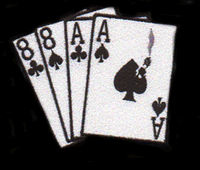 An email from Dreamtime listener Jennifer had me thinking about aces backed with eights. Jennifer wrote...
An email from Dreamtime listener Jennifer had me thinking about aces backed with eights. Jennifer wrote...While I was on my way to work this morning, I heard a song I hadn't listened to in a long time: "Rambin' Gamblin' Willie" from [Dylan's] first Bootleg Series set. I had forgotten that at the end of that song, Willie is shot, and he's holding the 'dead man's hand'--aces and eights. Just like {Dylan] mentioned in last year's Death & Taxes show.
If you're a poker player or were a fan of the late, lamented Deadwood series, you might know that most famous of dead man's hands. On the 2nd of August, 18 and 76, Wild Bill Hickok was playing cards in Deadwood, in what is now South Dakota, and then was simply known as the Dakotas, when Jack McCall shot him in the back of the head, killing him instantly. Legend has it Wild Bill held a pair of black eights and a pair of black Aces when he died, which became known both among poker players and popularly as a "dead man's hand."
McCall said he believed that Hickok had killed his brother in Kansas. Although from all reports McCall was a bad-natured drunk who didn't need much of an excuse to pull his gun, this may have even been correct. His brother Lew had supposedly died in Abilene, Kansas in a gunfight with a "lawman." In 1871 Hickok had been employed as a marshal in Abilene. He was paid $150 a month plus a bounty of 50 cents for every unlicensed dog he shot. While Hickok had spent most of his Abilene employment playing poker, he had shot and killed at least two men during his time there. One of the victims may have been Lew McCall. Other stories have it that Jack McCall had lost $110 to Hickok the night before and was still smarting - as well as still drunk.
Biographers have never found a contemporary citation confirming that Hickok was holding Aces and eights, and the term, dead man's hand,was in use 10 years after Hickok's murder in relation to a different set of cards. An 1886 article from the Grand Forks Daily Herald notes...
I was present at a game in a Senator's house one night and saw him win $6,000 on one hand. It was the dead man's hand.If you're a poker player, your immediate question would be what was the fifth card in Hickok's hand? Did he fill the full house? It's possible - since Wild Bill was playing draw poker - that he had already discarded a card and was shot down before he could draw the missing card. For reasons unknown the Stardust Casino in Las Vegas had a 5 of diamonds on display as the fifth card. With the Stardust now, ah, dust, the card has moved over to a display in Deadwood. Another display in Deadwood uses the 9 of diamonds, supposedly reported in first-hand accounts as the card. The 9 of diamonds was also used in the Deadwood series as the missing card.
What is the dead man's hand? Why, it is three jacks and a pair of tens. It is called the dead man's hand because about forty seven years ago, in a town in Illinois, a celebrated judge bet his house and lot on three jacks and a pair of tens.
When his opponent showed up he had three queens and a pair of tens. Upon seeing the queens the judge fell back dead, clutching the jacks and tens in his hand, and that's why a jack-full on tens is called the dead man's hand.
James Butler Hickok was buried in the Mt. Moriah Cemetery outside Deadwood. Calamity Jane insisted that the man she loved have a proper memorial, and had a stone enclosure with an iron filigree built around Hickok's burial plot.

In 1900, Calamity Jane was photographed next to the burial site. She posed with a flower in her hand, and she said in an interview published with the photo that when she died she wanted to be buried next to the man she loved.
Three years later, she was.
As I replied to Jennifer, I suspect that, like me, Our Host is a regular poker player. Between being pals with Ricky Jay (Ramblin' Gamblin' Willie also shows up on Jay's great compilation CD, Ricky Jay Plays Poker), and the very funny Love and Theft promo video, I think I've read that Dylan and the boys in the band while away the hours on the bus with some vicious poker games. And certainly Huck's Tune is filled with poker references and slang that you wouldn't know unless you were a Texas Hold `Em player.
I've thought of doing a poker-themed Dreamtime, and may still, although I wouldn't be surprised if TTRH does one first.












